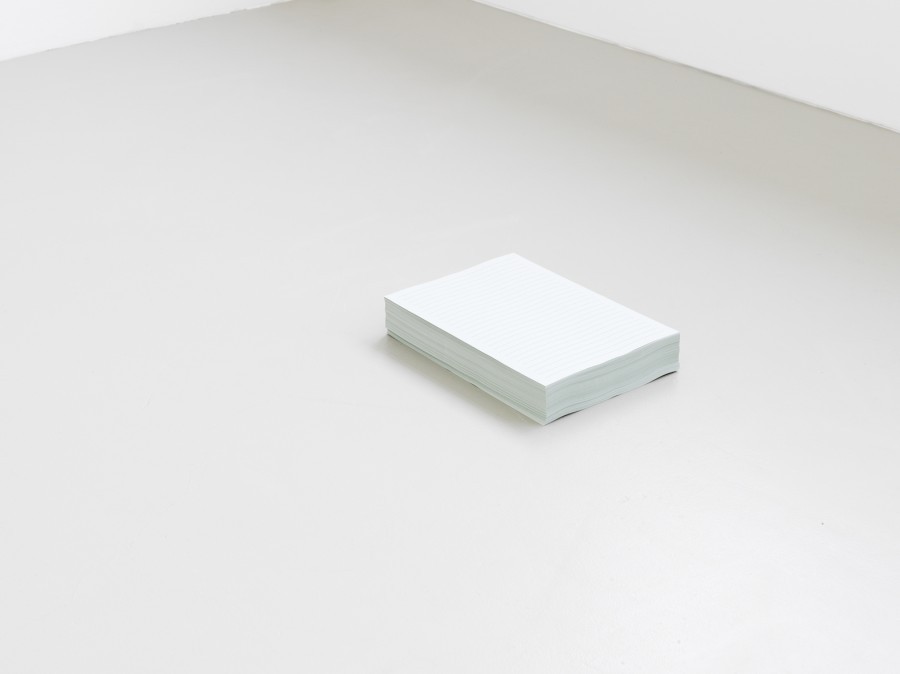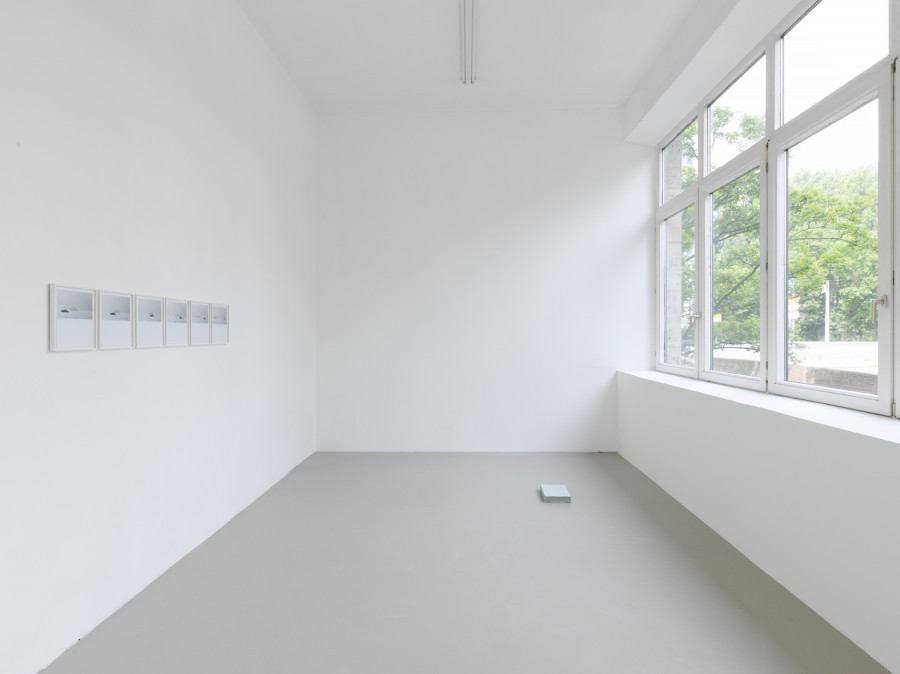Daniel Gustav Cramer
Seventeen
30 May - 09 Aug 2015

Daniel Gustav Cramer
Seventeen
Installation view, Kunstverein Nürnberg, 2015
Courtesy the artist; Sies+Höke, Düsseldorf; BolteLang, Zurich; Vera Cortês, Lisbon. Photo: Annette Kradisch.
Seventeen
Installation view, Kunstverein Nürnberg, 2015
Courtesy the artist; Sies+Höke, Düsseldorf; BolteLang, Zurich; Vera Cortês, Lisbon. Photo: Annette Kradisch.

Daniel Gustav Cramer
Untitled, 2015
Paper, printed, 21 x 29,7 cm
Kunstverein Nürnberg, 2015. Courtesy the artist; Sies+Höke, Düsseldorf; BolteLang, Zürich/Zurich; Vera Cortês, Lissabon/Lisbon. Photo: Annette Kradisch
Untitled, 2015
Paper, printed, 21 x 29,7 cm
Kunstverein Nürnberg, 2015. Courtesy the artist; Sies+Höke, Düsseldorf; BolteLang, Zürich/Zurich; Vera Cortês, Lissabon/Lisbon. Photo: Annette Kradisch

Daniel Gustav Cramer
XVI, 2014
Iron sphere, ⌀ 25 cm
Kunstverein Nürnberg, 2015. Courtesy the artist; Sies+Höke, Düsseldorf; BolteLang, Zürich/Zurich; Vera Cortês, Lissabon/Lisbon. Photo: Annette Kradisch.
XVI, 2014
Iron sphere, ⌀ 25 cm
Kunstverein Nürnberg, 2015. Courtesy the artist; Sies+Höke, Düsseldorf; BolteLang, Zürich/Zurich; Vera Cortês, Lissabon/Lisbon. Photo: Annette Kradisch.

Daniel Gustav Cramer
Seventeen
Installation view
Kunstverein Nürnberg, 2015
Courtesy the artist; Sies+Höke, Düsseldorf; BolteLang, Zurich; Vera Cortês, Lisbon. Photo: Annette Kradisch.
Seventeen
Installation view
Kunstverein Nürnberg, 2015
Courtesy the artist; Sies+Höke, Düsseldorf; BolteLang, Zurich; Vera Cortês, Lisbon. Photo: Annette Kradisch.
DANIEL GUSTAV CRAMER
Seventeen
30 May 2015 - 9 August 2015
The Kunstverein Nürnberg – Albrecht Dürer Gesellschaft is pleased to present a comprehensive solo exhibition by Daniel Gustav Cramer (b. 1975, Düsseldorf).
The starting point for Daniel Gustav Cramer’s artistic work is the subjective perception of the world and the things that inhabit it: apparitions and events that we encounter and how these inscribe themselves onto our consciousness. Abstract universal principles such as time and space come into play, along with fleeting details or fragments of nature and cultural history. Oscillating between the macro- and the microcosm of the experiential world, his artistic practice focuses on materialisations of remembering. His photographs, texts and sculptures are placeholders and traces of memory, which, unidentical with the actual experience, are always suffused with personal narratives
At Kunstverein Nürnberg, Daniel Gustav Cramer brings new and current works into the spaces of the Milchhof. Titled Seventeen, this show continues his sequence of exhibition projects that present various serial works. By repeating elements that are simultaneously constant and variable, Cramer unites own and researched images in a dynamic archive. Despite his recognizably systematic methodology, Cramer emphasizes the potential of gaps in facts and content that are inherent in collections. This fundamental principle underlies the white constructions in the existing exhibition spaces, which intervene to create a neutralized, sculptural architecture where spatial voids enable the individual works to enter into dialogue with one another.
One of the central exhibition pieces is a new textual work, comprising a literary fragment printed on stacked sheets of paper that visitors can take home. It uses precise language to recount the memory of driving to a particular place, recalling the smells, sounds and objects that briefly shape perception, and how the permeability of the internal and external world fuses their experience on the journey. The idea of proximity and distance, the appearance and dissipation of scenery and things, is a constant theme that runs throughout the exhibition as a whole. Cramer translates the preservation of memory into linguistic and sculptural forms, in which simple, fleeting structures coalesce into shifting mental images.
An important motif is the symbolic line ruling, as the basis and starting point of writing. This motif can be found in the empty note sheets that are presented as object-like text blocks, in the metallic bars as well as the filigree frame sculptures that structure the space like windows in time. In the series Tales (Lago d'Iseo, Italy, March 2014), 2014, Cramer visually translates the passage of time as a line: similar to a cinematic sequence, it comprises six photographs of a passenger ship that passes along Lake Iseo in Lombardy at the Isola di San Paolo. In the course of its observation, it successively reveals that the perception is not linear, but proceeds with temporal and spatial interruptions.
In the photographs Untitled (Carte Du Ciel) I and II, 2012, Cramer again addresses shifts in time-based measurements and observations. In 1860, Ernest Mouchez, a French astronomer and director of the Paris Observatory, initiated a project to photograph all the visible stars in the night sky and to chart their positions in a comprehensive map. Although numerous observatories were involved in the project for decades, the endeavour was eventually discontinued because there were simply too many stars. Cramer’s photographs include an excerpt of this documentation, in which the perception of the stars’ relational proportions on the line grid constantly shifts between their actual form and their universal significance.
Cramer’s use of image and language – be it through the cartographic titles or the fragmented texts – interweaves references to conceptual and literary artistic strategies. His sculptural statements and linguistic notes follow the artistic idea that individual works are reduced gestures that become legible only in their mutual referentiality. Cramer applies this emphasis on conceptual variability to nature, the materiality of objects and the layers of history that they entail. At the same time, the power of memory and the narrative becomes a unifying element that brings together the singular items into a time continuum that can be individually experienced by the viewer in the exhibition space.
Daniel Gustav Cramer (b. 1975, Düsseldorf) lives in Berlin. In the last years he presented his works in international solo exhibitions as for example at SALTS, Basel (2014), at Kunstwerke Berlin (2014), at Kunsthalle Mulhouse (2013), at Kunsthaus Glarus (2012) as well as at Dortmunder Kunstverein (2010). Upcoming solo projects he will show at Vila du parc, Cente d’art contemporain, Annemasse, as well as at Kunstsaele, Berlin in 2015. Besides, he was represented in numerous group exhibitions as in Terra Incognita, KIT, Düsseldorf (2015); in Construire une Collection, Villa Paloma, Nouveau Musee National, Monaco (2015); in Library Vaccine, Artists Space, New York (2014); in The Unicorn, Transformer Station, The Cleveland Museum of Art, Cleveland (2013); in AB, Nomas Foundation, Rome, as well as at the dOCUMENTA(13), Kassel (2012)
Seventeen
30 May 2015 - 9 August 2015
The Kunstverein Nürnberg – Albrecht Dürer Gesellschaft is pleased to present a comprehensive solo exhibition by Daniel Gustav Cramer (b. 1975, Düsseldorf).
The starting point for Daniel Gustav Cramer’s artistic work is the subjective perception of the world and the things that inhabit it: apparitions and events that we encounter and how these inscribe themselves onto our consciousness. Abstract universal principles such as time and space come into play, along with fleeting details or fragments of nature and cultural history. Oscillating between the macro- and the microcosm of the experiential world, his artistic practice focuses on materialisations of remembering. His photographs, texts and sculptures are placeholders and traces of memory, which, unidentical with the actual experience, are always suffused with personal narratives
At Kunstverein Nürnberg, Daniel Gustav Cramer brings new and current works into the spaces of the Milchhof. Titled Seventeen, this show continues his sequence of exhibition projects that present various serial works. By repeating elements that are simultaneously constant and variable, Cramer unites own and researched images in a dynamic archive. Despite his recognizably systematic methodology, Cramer emphasizes the potential of gaps in facts and content that are inherent in collections. This fundamental principle underlies the white constructions in the existing exhibition spaces, which intervene to create a neutralized, sculptural architecture where spatial voids enable the individual works to enter into dialogue with one another.
One of the central exhibition pieces is a new textual work, comprising a literary fragment printed on stacked sheets of paper that visitors can take home. It uses precise language to recount the memory of driving to a particular place, recalling the smells, sounds and objects that briefly shape perception, and how the permeability of the internal and external world fuses their experience on the journey. The idea of proximity and distance, the appearance and dissipation of scenery and things, is a constant theme that runs throughout the exhibition as a whole. Cramer translates the preservation of memory into linguistic and sculptural forms, in which simple, fleeting structures coalesce into shifting mental images.
An important motif is the symbolic line ruling, as the basis and starting point of writing. This motif can be found in the empty note sheets that are presented as object-like text blocks, in the metallic bars as well as the filigree frame sculptures that structure the space like windows in time. In the series Tales (Lago d'Iseo, Italy, March 2014), 2014, Cramer visually translates the passage of time as a line: similar to a cinematic sequence, it comprises six photographs of a passenger ship that passes along Lake Iseo in Lombardy at the Isola di San Paolo. In the course of its observation, it successively reveals that the perception is not linear, but proceeds with temporal and spatial interruptions.
In the photographs Untitled (Carte Du Ciel) I and II, 2012, Cramer again addresses shifts in time-based measurements and observations. In 1860, Ernest Mouchez, a French astronomer and director of the Paris Observatory, initiated a project to photograph all the visible stars in the night sky and to chart their positions in a comprehensive map. Although numerous observatories were involved in the project for decades, the endeavour was eventually discontinued because there were simply too many stars. Cramer’s photographs include an excerpt of this documentation, in which the perception of the stars’ relational proportions on the line grid constantly shifts between their actual form and their universal significance.
Cramer’s use of image and language – be it through the cartographic titles or the fragmented texts – interweaves references to conceptual and literary artistic strategies. His sculptural statements and linguistic notes follow the artistic idea that individual works are reduced gestures that become legible only in their mutual referentiality. Cramer applies this emphasis on conceptual variability to nature, the materiality of objects and the layers of history that they entail. At the same time, the power of memory and the narrative becomes a unifying element that brings together the singular items into a time continuum that can be individually experienced by the viewer in the exhibition space.
Daniel Gustav Cramer (b. 1975, Düsseldorf) lives in Berlin. In the last years he presented his works in international solo exhibitions as for example at SALTS, Basel (2014), at Kunstwerke Berlin (2014), at Kunsthalle Mulhouse (2013), at Kunsthaus Glarus (2012) as well as at Dortmunder Kunstverein (2010). Upcoming solo projects he will show at Vila du parc, Cente d’art contemporain, Annemasse, as well as at Kunstsaele, Berlin in 2015. Besides, he was represented in numerous group exhibitions as in Terra Incognita, KIT, Düsseldorf (2015); in Construire une Collection, Villa Paloma, Nouveau Musee National, Monaco (2015); in Library Vaccine, Artists Space, New York (2014); in The Unicorn, Transformer Station, The Cleveland Museum of Art, Cleveland (2013); in AB, Nomas Foundation, Rome, as well as at the dOCUMENTA(13), Kassel (2012)
